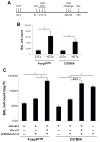Adjuvant effect of diphtheria toxin after mucosal administration in both wild type and diphtheria toxin receptor engineered mouse strains
- PMID: 24200744
- PMCID: PMC3873768
- DOI: 10.1016/j.jim.2013.10.010
Adjuvant effect of diphtheria toxin after mucosal administration in both wild type and diphtheria toxin receptor engineered mouse strains
Abstract
The finding that murine and simian cells have differential susceptibility to diphtheria toxin (DTx) led to the development of genetically engineered mouse strains that express the simian or human diphtheria toxin receptor (DTR) under the control of various mouse gene promoters. Injection of DTx into DTR engineered mice allows for rapid and transient depletion of various cell populations. There are several advantages to this approach over global knockout mice, including normal mouse development and temporal control over when cell depletion occurs. As a result, many DTR engineered mouse strains have been developed, resulting in significant insights into the cell biology of various disease states. We used Foxp3(DTR) mice to attempt local depletion of Foxp3+ cells in the lung in a model of tolerance breakdown. Intratracheal administration of DTx resulted in robust depletion of lung Foxp3+ cells. However, DTx administration was accompanied by significant local inflammation, even in control C57Bl/6 mice. These data suggest that DTx administration to non-transgenic mice is not always an immunologically inert event, and proper controls must be used to assess various DTx-mediated depletion regimens.
Keywords: Diphtheria toxin; Lung; Regulatory T cells; Tolerance.
© 2013.
Figures


Similar articles
-
Deletion of Foxp3+ regulatory T cells in genetically targeted mice supports development of intestinal inflammation.BMC Gastroenterol. 2012 Jul 31;12:97. doi: 10.1186/1471-230X-12-97. BMC Gastroenterol. 2012. PMID: 22849659 Free PMC article.
-
Limitations of Foxp3(+) Treg depletion following viral infection in DEREG mice.J Immunol Methods. 2014 Apr;406:58-65. doi: 10.1016/j.jim.2014.03.005. Epub 2014 Mar 15. J Immunol Methods. 2014. PMID: 24642426 Free PMC article.
-
Impairment of podocyte function by diphtheria toxin--a new reversible proteinuria model in mice.Lab Invest. 2012 Dec;92(12):1674-85. doi: 10.1038/labinvest.2012.133. Epub 2012 Sep 24. Lab Invest. 2012. PMID: 23007132
-
Transient Treg depletion enhances therapeutic anti-cancer vaccination.Immun Inflamm Dis. 2016 Nov 21;5(1):16-28. doi: 10.1002/iid3.136. eCollection 2017 Mar. Immun Inflamm Dis. 2016. PMID: 28250921 Free PMC article.
-
Local "on-demand" generation and function of antigen-specific Foxp3+ regulatory T cells.J Immunol. 2013 May 15;190(10):4971-81. doi: 10.4049/jimmunol.1202625. Epub 2013 Apr 12. J Immunol. 2013. PMID: 23585681 Free PMC article.
Cited by
-
Ablation of Pericyte-Like Cells in Lungs by Oropharyngeal Aspiration of Diphtheria Toxin.Am J Respir Cell Mol Biol. 2017 Feb;56(2):160-167. doi: 10.1165/rcmb.2016-0083MA. Am J Respir Cell Mol Biol. 2017. PMID: 27779900 Free PMC article.
-
Targeted ablation of Lgr5-expressing intestinal stem cells in diphtheria toxin receptor-based mouse and organoid models.STAR Protoc. 2022 May 18;3(2):101411. doi: 10.1016/j.xpro.2022.101411. eCollection 2022 Jun 17. STAR Protoc. 2022. PMID: 35620071 Free PMC article.
-
AgRP neurons are not indispensable for body weight maintenance in adult mice.Cell Rep. 2023 Jul 25;42(7):112789. doi: 10.1016/j.celrep.2023.112789. Epub 2023 Jul 8. Cell Rep. 2023. PMID: 37422762 Free PMC article.
-
IgE-activated mast cells enhance TLR4-mediated antigen-specific CD4+ T cell responses.Sci Rep. 2021 May 6;11(1):9686. doi: 10.1038/s41598-021-88956-4. Sci Rep. 2021. PMID: 33958642 Free PMC article.
-
Regulatory T cells constrain the TCR repertoire of antigen-stimulated conventional CD4 T cells.EMBO J. 2018 Feb 1;37(3):398-412. doi: 10.15252/embj.201796881. Epub 2017 Dec 20. EMBO J. 2018. PMID: 29263148 Free PMC article.
References
-
- Middlebrook JL, Dorland RB. Response of cultured mammalian cells to the exotoxins of pseudomonas aeruginosa and corynebacterium diphtheriae: Differential cytotoxicity. Canadian journal of microbiology. 1977;23:183–189. - PubMed
-
- Naglich JG, Metherall JE, Russell DW, Eidels L. Expression cloning of a diphtheria toxin receptor: Identity with a heparin-binding egf-like growth factor precursor. Cell. 1992;69:1051–1061. - PubMed
-
- Cha JH, Brooke JS, Eidels L. Toxin binding site of the diphtheria toxin receptor: Loss and gain of diphtheria toxin binding of monkey and mouse heparin-binding, epidermal growth factor-like growth factor precursors by reciprocal site-directed mutagenesis. Molecular microbiology. 1998;29:1275–1284. - PubMed
-
- Hooper KP, Eidels L. Glutamic acid 141 of the diphtheria toxin receptor (hb-egf precursor) is critical for toxin binding and toxin sensitivity. Biochemical and biophysical research communications. 1996;220:675–680. - PubMed
Publication types
MeSH terms
Substances
Grants and funding
LinkOut - more resources
Full Text Sources
Other Literature Sources
Medical
Research Materials

